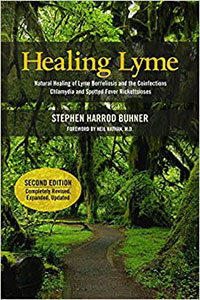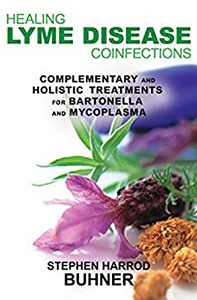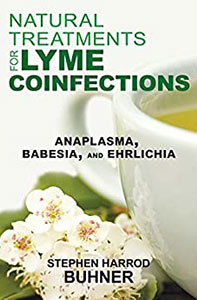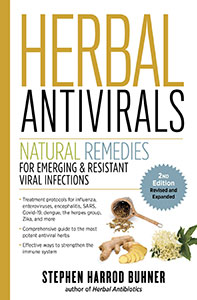I have read your book and most recent Public Health Alert with your recommendations. There is a local herbalist willing to collect Japanese knotweed to supply my patients, and that seems most consistent with your philosophy of local treatments of lyme disease. Are there guidelines for her to use in collecting (time of year), drying (is sauna OK), and dosing? Thank you.
Collect the root anytime, however it is strongest in spring. It should be cut up and air dried out of the sun; I would not use a sauna. Buy 00 capsules, fill and take as directed in the book OR take 1 tbl 3-4x daily blended in juice.
Author
-

Stephen Harrod Buhner was an Earth poet and an award-winning author of twenty-four books on nature, indigenous cultures, the environment, and herbal medicine including the acclaimed book Healing Lyme: Natural Healing & Prevention of Lyme Borreliosis & Its Co-infections.
View all posts
Stephen came from a long line of healers including Leroy Burney, Surgeon General of the United States under Eisenhower and Kennedy, and Elizabeth Lusterheide, a midwife and herbalist who worked in rural Indiana in the early nineteenth century. The greatest influence on his work, however, was his great-grandfather C.G. Harrod who primarily used botanical medicines, also in rural Indiana, when he began his work as a physician in 1911.
Stephen’s work has appeared or been profiled in publications throughout North America and Europe including Common Boundary, Apotheosis, Shaman’s Drum, The New York Times, CNN, and Good Morning America. Stephen lectured yearly throughout the United States on herbal medicine, the sacredness of plants, the intelligence of Nature, and the states of mind necessary for successful habitation of Earth.
He was a tireless advocate for the reincorporation of the exploratory artist, independent scholar, amateur naturalist, and citizen scientist in American society – especially as a counterweight to the influence of corporate science and technology.












Hey there
Loving your new book. Thanks for that update.
Its the new gold standard.
Can I put this site on my internet link page ?
Everyone should visit here!
Cheers Jill
Oh Dear! I am a rather experienced plant person. Decided to dig my own knotweed a year or so ago.
The roots were so tough, knotty and hard that I never was able to use them!
For this reason, I suggest that one dig younger roots in the spring.
Of course this is only my first experience and as we all know, plants and their attributes will vary from place to place and soil to soil. I dug Autumn roots from well established older plants in Ontario. I was sad to have to throw them back to the earth, but obviously they were not in a mood to contribute medicine to me and mine! Hopefully I will find some willing roots in Spring, perhaps babies of the mother taps iI ATTEMPTED TO USE last fall.
Hello there,
With regard to Japanese Knotweed: it may be quite important to wear thick GLOVES when harvesting. (Hmm… common sense?) Having handled a mass of roots over the course of a few hours’ digging and prepping last spring, I believe I “foraged” myself into a full-fledged Herx reaction.
It was quite severe: all of my worst Lyme symptoms; of course my feet were very painful. I was unable to walk for two weeks.
I hope this may save someone the pain. It may be that the roots were completely unrelated. But embarrassingly, I don’t know – because I cut corners!
BTW Japanese Knotweed is all over the place in NH. Google the image and habitat, then take a drive up and down 93. Hope I helped someone :-)
I could use some Karma!
Has anyone tried drying the root in a dehydrator? It’s very wet here this time of year, and I’m worried about mold if drying slowly. Thanks!
Candace… I am a Chartered Herbalist and from what I have learned when air dried and out of the sun obviously this is a slow process. If in a warm area of your home in which the humidity level is low this will be ok. (I bought an indoor thermometer that also gives the humidity reading at my local hardware store – they are not expensive.)
As for dehydrators I would “suspect” this should work so long as it is on the absolute lowest setting! I can not say this with 100 percent certainty though.
Can you make tincture from fresh Japanese Knotweed root, or does it need to be dried first? Thanks!
I always dry it on a dehydrator. Works great. I have a simple element style electric one without a fan. No problems with mold.
Ditto Terry’s question above about whether the root ideally ought to be dried prior to making the tincture
Ditto Terry and Kaitlin’s questions.
no, you don’t have to dry it to make tincture, it works dried or fresh.
I’m wondering if anyone knows if you have to peel the root before drying? ??
Thanks for any opinions
I don’t peal the roots. There is alot of orange (resveratrol that would be discarded
@beautifuldreamer
Thank You SO MUCH!!
I have dried my root with out peeling it, and it dried great. Also made tincture with fresh and dried root, worked great!
But now, Im trying to grind up the root, and it is so hard coffee grinder is struggling.
Should i have chopped the roots in small pieces before drying?
I chopped them up with small pruning scissors *clean* after drying, but they are so hard?
Were They dried too long? Do i need to use a certain grinder? And when i finally get it ground it is very fibrous. Is this Normal?
I will REALLY appreciate any suggestions etc.
THANK YOU! :)
Hello Abigail. I just found this post. I also am in New Hampshire and have recently started harvesting knot weed. Making tinctures. Are you still working with knotweed?
From my research…it is the standard to use 60 mesh screen to sift out herbs in general. I like your idea of pre- chopping than dehydrating or drying. My strategy will be to chop fresh root into bits with a cleaver. Than run about four to six oz. through my very powerful Vita Mix blender. I will sift it through 60 mesh. Whatever does not sift, I will add back to blender with more pieces and repeat process til all is sifted. I think it is worthwhile to note that most recipies for tincture are based on using dry knotweed. So, bear in mind if trying to make medicine from fresh, you will have a lot of water weight to consider in the equation of fresh vs. dry.
This is important to have reasonably uniform potency. I will weigh the knotweed wet and dry to have a working knowledge of how much weight is water weight. I imagine higher alchohol content is advisable if extracting fresh as well.
The only alcohol I don’t react badly to is mezcal tequila, but it’s only 45% alcohol- can I use that to make my dried Japanese knotweed tincture?
From what I recall in herb class fresh herbs are 50% water weight
That should work fine
On average, how mamy mg of resveratrol in one gram of root?